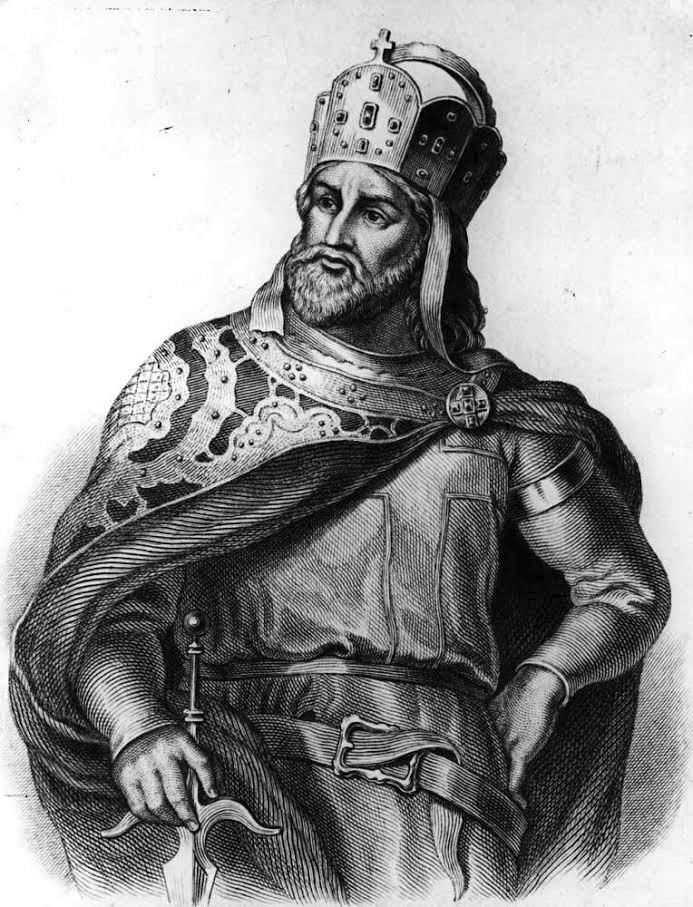A Family Genealogy of
the Gentle House of Stapleton
the Gentle House of Stapleton
HomeFamily ListDatabaseSurname IndexIndex of IndividualsIndex of Noble HousesFamous and Infamous People
(Holy Roman Emperor) Frederick III HOHENSTAUFEN #63161
DEC 1122 - 10 JUN 1190
AKA: Frederic I Barbarossa
Personal Information
- TITLE: Holy Roman Emperor
- BIRTH: DEC 1122, Haguenau, Bas-Rhin, Alsace, France
- DEATH: 10 JUN 1190, Antalya, Turkey
Notes
Frederick Barbarossa, also known as Frederick I, was the Holy Roman Emperor from 1155 until his death in 1190. He was elected King of Germany in Frankfurt on 4 March 1152 and crowned in Aachen on 9 March 1152. He was crowned King of Italy on 24 April 1155 in Pavia and emperor by Pope Adrian IV on 18 June 1155 in Rome. Two years later, the term sacrum ("holy") first appeared in a document in connection with his empire. He was later formally crowned King of Burgundy, at Arles on 30 June 1178. His nickname of Barbarossa (meaning "Red Beard" in Italian) "was first used by the Florentines only in 1298 to differentiate the emperor from his grandson, Frederick II ... and was never employed in medieval Germany" (the colour red was "also associated in the Middle Ages with malice and a hot temper"; in reality, Frederick's hair was "blond", although his beard was described by a contemporary as "reddish"). In German, he was known as Kaiser Rotbart, which in English means "Emperor Redbeard". The prevalence of the Italian nickname, even in later German usage, reflects the centrality of the Italian campaigns under his reign, and "remains to this day one of the [most] powerful historical monikers."
Frederick was by inheritance Duke of Swabia (1147-1152, as Frederick III) before his imperial election in 1152. He was the son of Duke Frederick II of the Hohenstaufen dynasty and Judith, daughter of Henry IX, Duke of Bavaria, from the rival House of Welf. Frederick, therefore, descended from the two leading families in Germany, making him an acceptable choice for the Empire's prince-electors. Frederick joined the Third Crusade and opted to travel overland to the Holy Land. In 1190, Frederick drowned attempting to cross the Saleph River, leading to most of his army abandoning the Crusade before reaching Acre.
Historians consider him among the Holy Roman Empire's greatest medieval emperors. He combined qualities that made him appear almost superhuman to his contemporaries: his longevity, his ambition, his extraordinary skills at organization, his battlefield acumen, and his political perspicacity. His contributions to Central European society and culture include the re-establishment of the Corpus Juris Civilis, or the Roman rule of law, which counterbalanced the papal power that dominated the German states since the conclusion of the Investiture controversy. Due to his popularity and notoriety, in the 19th and early 20th centuries, he was used as a political symbol by many movements and regimes: the Risorgimento, the Wilhelmine government in Germany (especially under Emperor Wilhelm I), and the Nazi movement (Operation Barbarossa, Barbarossa decree) resulting in mixed legacies. Modern researchers, while exploring the legacy of Frederick, attempt to untangle legend from historical reality-these efforts result in new perspectives on both the emperor as a person and the social developments associated with him.
Frederick was by inheritance Duke of Swabia (1147-1152, as Frederick III) before his imperial election in 1152. He was the son of Duke Frederick II of the Hohenstaufen dynasty and Judith, daughter of Henry IX, Duke of Bavaria, from the rival House of Welf. Frederick, therefore, descended from the two leading families in Germany, making him an acceptable choice for the Empire's prince-electors. Frederick joined the Third Crusade and opted to travel overland to the Holy Land. In 1190, Frederick drowned attempting to cross the Saleph River, leading to most of his army abandoning the Crusade before reaching Acre.
Historians consider him among the Holy Roman Empire's greatest medieval emperors. He combined qualities that made him appear almost superhuman to his contemporaries: his longevity, his ambition, his extraordinary skills at organization, his battlefield acumen, and his political perspicacity. His contributions to Central European society and culture include the re-establishment of the Corpus Juris Civilis, or the Roman rule of law, which counterbalanced the papal power that dominated the German states since the conclusion of the Investiture controversy. Due to his popularity and notoriety, in the 19th and early 20th centuries, he was used as a political symbol by many movements and regimes: the Risorgimento, the Wilhelmine government in Germany (especially under Emperor Wilhelm I), and the Nazi movement (Operation Barbarossa, Barbarossa decree) resulting in mixed legacies. Modern researchers, while exploring the legacy of Frederick, attempt to untangle legend from historical reality-these efforts result in new perspectives on both the emperor as a person and the social developments associated with him.
Parents
Father: Frederick II HOHENSTAUFEN #63353
Mother: Judith of WELF #63354
Family 1 :
Wife: Beatrice I of IVREA
Children:
-
+Henry VI HOHENSTAUFEN #63160 -
-
-
-
-
+Otto I HOHENSTAUFEN #63751 -
-
-
-
+Philip HOHENSTAUFEN #63755 -
Family 2 :
Wife: Adelaide of VOHBURG

_Frederick HOHENSTAUFEN _
| (1020 - 1053)
_Frederick I HOHENSTAUFEN _|
| (1050 - 1105) |
| |_Hildegard of EGISHEIM __
| (.... - 1050)
_Frederick II HOHENSTAUFEN _|
| (1090 - 1147) |
| | _Henry IV SALIAN ________+
| | | (1050 - 1106)
| |_Agnes of SALIAN __________|
| (1072 - 1143) |
| |_Bertha of SAVOY ________
| (1051 - 1087)
|
|--Frederick III HOHENSTAUFEN
| (1122 - 1190)
| _Welf IV WELF ___________+
| | (1035 - 1101)
| _Henry IX WELF ____________|
| | (1075 - 1126) |
| | |_Judith of FLANDERS _____+
| | (1030 - 1094)
|_Judith of WELF ____________|
(1100 - 1130) |
| _Magnus BILLUNG _________+
| | (1045 - 1106)
|_Wulfhilde of BILLUNG _____|
(1072 - 1126) |
|_Sophia of ÁRPÁD ______+
(1050 - 1095)